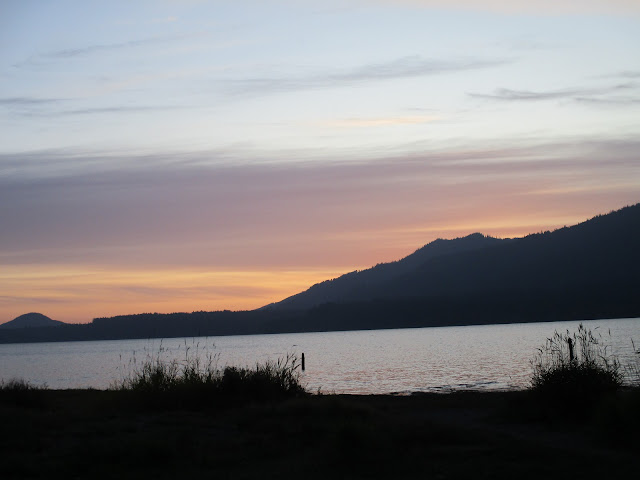We had a couple of weeks before our last Oregon host position, so we headed north to visit a few sites that we had missed on previous visits. Olympic National Park is on Washington's Olympic Peninsula in the Pacific Northwest sprawling across several different ecosystems, from the peaks of the Olympic Mountains to old-growth forests. The glacier-clad Mt. Olympus cuts through the park's rainforests and along its Pacific coastline.

Since many of the campgrounds are first come first serve and few that could accommodate our 24 feet, we planned to arrive early to try and snag a place to stay after delaying our arrival for a day due to the Hobie competition being held over the weekend. Most of the campers had left by the time we arrived at Quinault's Rainforest Campground. Site number one is the only lake front site and happened to be open when we pulled up. Lucky for us.
Quinault Lake, WA
The park’s four rain forests are part of a huge Pacific Northwest rainforest that once stretched from Oregon’s southern coast to southeastern Alaska. Because of development, very few temperate rainforests outside of Olympic National Park exist along this stretch today.
But what makes a temperate forest? Rain. Rain. And more rain ? 12-14 feet per year, to be exact in Olympic. Climate also is important. In Olympic, temperatures rarely drop below freezing or go above 80F, enabling an incredibly unique ecosystem to grow.
Loggers cut he notch in the middle of the stump to place a board to stand on while cutting down the tree.
Quinault Rain Forest is home to the world’s largest Sitka spruce tree that is more than 1,000 years old. Quinault also has several waterfalls, including Merriman Falls along the narrow South Shore Road. We didn't have a problem getting past the few oncoming vehicles.
On the way back, we took the North Shore Road. We didn't like that side at all. It was more narrow without many turnouts and steep cliffs at times. Without a place to turn around, I assumed the quiet mode. We only met three vehicles which we shimmied past. Fortunately, we were on a good section when a huge truck with gravel came around the corner. I am not sure how that would have played out two miles back.
On the way back, we took the North Shore Road. We didn't like that side at all. It was more narrow without many turnouts and steep cliffs at times. Without a place to turn around, I assumed the quiet mode. We only met three vehicles which we shimmied past. Fortunately, we were on a good section when a huge truck with gravel came around the corner. I am not sure how that would have played out two miles back.
It was hard to resist the blueberries, huckleberries and blackberries on our hikes,
On the way to Ruby Beach and low tide not happening for a while, we stopped at Kalalock Lodge for brunch overlooking the ocean.
Ruby Beach
There was enough misty rain to make the pictures more interesting.
Anemones in tide pools
Forks, WA
Logger's memorial
Darn telemarketers
Forks is a great location for Mitch Dodds, the mountain man TV fellow and the Twilight movies. The foggy mornings and steam rising off the logs as the sun shines through the trees give an eerie feel. They have been good to Forks. Many improvements have been made to the area since we last visited 12 years ago.
On previous visits, we missed several sections of the National Park and took the opportunity to visit them this time. It was much wetter then. August is one of the driest months in the rainforest. But this year western Washington is suffering from a serious drought. The local towns are even considering water restictions.
When we see the sun shining through spiderwebs, I remember hiking in Costa Rica with a guide. Mike took a right hand path while we followed the guide to the left. I suddenly said "stop" in a firm voice, fortunately Mike listened this time. He was close to walking into a large spider web with an equally large spider in the middle of the web at face level.
Fall seems to be arriving early.
Even though the waterfalls were smaller than usual,




























